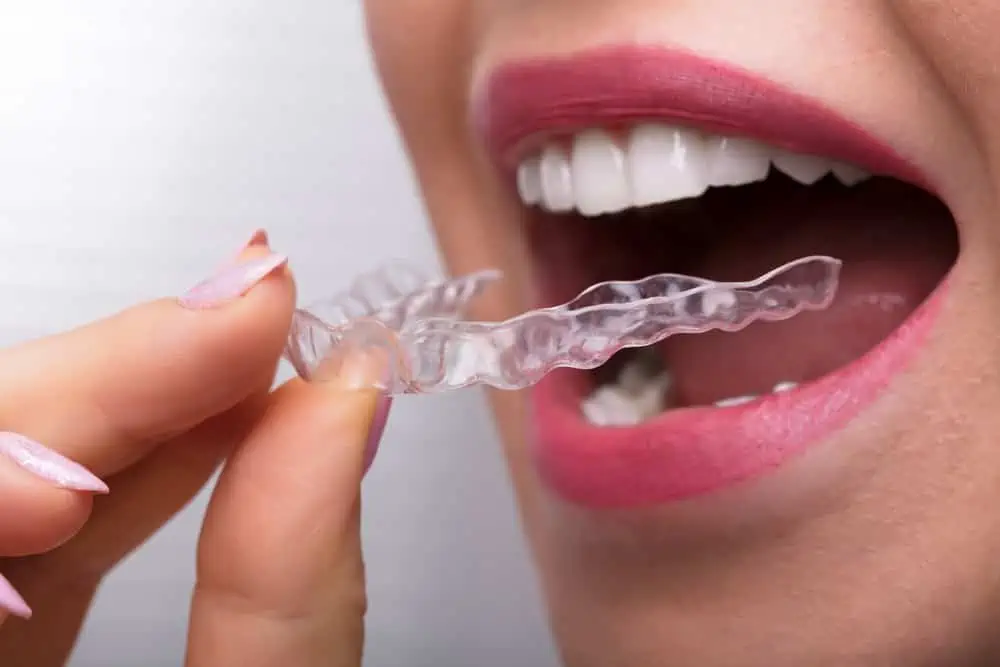Are you considering straightening your teeth?
Invisalign® aligners have become a popular option for those looking for an effective and less visible way to straighten their smile.
Unveiling the magic, this article will discuss how aligners straighten your teeth, the benefits, the process, the types of aligners, materials used, care and maintenance, the best candidate, and alternatives.
Our goal is to provide you with the information you need to make an informed decision about your own dental health.
What Are Aligners
The recent introduction of aligners has revolutionized the way teeth are straightened. Aligners, also known as invisible braces, are a type of orthodontic treatment used to correct misaligned teeth. These aligner trays are made from thin, clear plastic and fit snugly over the teeth, allowing for a more discreet option than traditional metal braces. Compared to other forms of orthodontic treatment, aligner treatment typically has a shorter duration, sometimes as little as 12 weeks.
Aligner therapy is provided by a number of different aligner companies, and each company has its own unique aligner system. During the treatment, patients receive a series of aligner trays that are designed to gradually move the teeth into the desired position. The aligners are made to be worn for a specific amount of time and then replaced with a new aligner tray.
Aligners are a convenient orthodontic treatment, as they are removable, making it easy to eat, brush, and floss. In addition, they are virtually invisible, so they are less noticeable than traditional metal braces.
Aligners are an effective way to straighten teeth and can be used to correct a wide range of misaligned teeth. They are also well suited to adult orthodontics patients who want a discreet treatment option.
Aligner Benefits
With a number of benefits, aligners are becoming a popular choice for those looking to straighten their teeth. One of the most obvious advantages of aligners is that they are far less noticeable than traditional braces. In addition, they are more comfortable, easier to maintain, and can be removed when eating or brushing your teeth. This makes them a great choice for individuals looking for a more discreet option.
Aligners can also help those with crowded teeth, where traditional braces may not be as effective. Aligners are designed to fit snugly and apply consistent pressure, which can help move teeth into a more desirable position. This is done through customized treatment plans that are tailored to each individual’s needs and can be adjusted as needed throughout the course of treatment.
The treatment time with aligners is typically shorter than with traditional braces, with many people seeing results in as little as six months. Additionally, aligners can help reduce the risk of complications as the plastic aligners are less likely to be damaged than traditional metal braces.
Ultimately, aligners are an ideal way to achieve a beautiful smile without the hassle of traditional braces. With custom aligners, patients can be sure that their tooth movements will be carefully monitored, allowing for a straighter smile in a shorter amount of time. Aligners can be an excellent choice for those looking to achieve a straighter smile without sacrificing comfort or convenience.
The Process
Using advanced technology, aligners are designed to gradually move teeth into the desired positions. Aligners are a popular orthodontic treatment option for those looking to achieve a straight smile without the use of wires and brackets. The entire process begins with dental impressions of the patient’s teeth. This information is then used to create a 3D scan of the teeth. From there, the aligners can be created, and the aligner treatment can begin.
The aligners are designed to put gentle pressure on the teeth in order to move them into the desired positions. The aligners are worn for a few weeks at a time and then replaced with the next set in the series. This process is repeated until the desired results are achieved. The amount of time required for treatment can vary based on the complexity of the bite issues being addressed. Generally, treatment time can range from a few months to a year.
Aligners can be a great choice for those looking for a more discreet and comfortable orthodontic solution. They can also be effective in treating a variety of bite issues, such as overcrowding, misalignment, and spacing issues. However, for more complex issues, traditional braces may be a better choice.
Types of Aligners
Building on the discussion of the process of using aligners to straighten teeth, there are several types of aligners available to meet the individual needs of patients. Depending on the orthodontic issues present, a metal wire and bracket system may be used, or the patient may be prescribed plastic trays that are replaced in a series of trays over a specified timeframe. Patients with deeper bites can benefit from a digital scan to create a custom aligner option that fits their mouth perfectly.
For those using clean aligners, the patient wears a series of aligners that gradually move the teeth into the desired position. As the trays are replaced, the patient will notice a gradual shift in the teeth. Aligners are also suitable for closing gaps between teeth as well as correcting misalignment issues.
Aligners offer patients a comfortable and convenient option to straighten teeth and correct orthodontic issues. With a commitment to wearing the aligners for the prescribed amount of time, patients can enjoy the benefits of a beautiful smile with minimal adjustment time in between trays. As the patient progresses through the aligners, they will enjoy the confidence that comes with a straight smile.
Materials Used
By leveraging the materials used in production, aligners can effectively shift teeth into the desired position. Through the use of custom-made aligners, orthodontic treatment options have become much more accessible to those seeking a straighter smile. These aligners are made from a clear, medical-grade plastic that is moulded to fit each patient’s individual dental structure to provide gentle pressure for gradual and precise tooth movement.
The aligner process begins with an initial consultation with the patient, during which a dental health professional will take impressions and create an aligner model. This model is then used to create the aligner kit, which includes multiple sets of aligner trays. The patient progresses through each tray, wearing them for a certain amount of time before switching to the next.
In order to ensure optimal results, it is important to practice good oral hygiene while wearing aligners. This includes brushing and flossing after every meal, as well as keeping the aligner trays clean with a specialized product. This will help reduce plaque buildup and bad breath, as well as minimize the chances of developing cavities.
Care & Maintenance
Once the aligners are in place, proper care and maintenance is essential for achieving the desired outcome. Taking care of your aligners is important because it helps to ensure that teeth move into their correct position over time and that a healthy, straight, and beautiful smile is achieved. It is recommended that aligners be worn for at least 22 hours per day to ensure that they are in the correct position for the desired result.
In addition to wearing the aligners for the required amount of time, it is also important to clean the aligners regularly to prevent bacteria buildup and tooth decay. The aligners should be brushed with a soft toothbrush and water and then rinsed before and after use. It is also important to clean the gaps in teeth between the aligners, as bacteria can build up in these areas and cause tooth decay.
It is also important to practice good oral hygiene when wearing aligners, as plaque and bacteria can build up around the aligners and lead to tooth decay. Brushing and flossing regularly and avoiding sugary and sticky foods are important steps to take to ensure a healthy smile.
For those who are not comfortable with the traditional aligners, lingual braces are also available. These braces are hidden on the back side of the teeth, so they are not visible to others. They work in a similar way as the traditional aligners, but they use a 3D model to move the teeth into the desired position.
The care and maintenance of aligners is essential for achieving straighter teeth. By following the instructions provided by the orthodontist and taking care of the aligners properly, individuals will be able to achieve the desired result of a healthy, straight, and beautiful smile.
Best Candidate
Taking care of aligners and practising good oral hygiene are important steps to take for those considering aligners to achieve a healthy, straight, and beautiful smile. But who is the best candidate for aligners? Crooked teeth are a common reason for seeking orthodontic treatment. In some cases, metal braces may be recommended, but aligners are a great teeth straightening option for those who desire a perfect smile without the pain and inconvenience of metal braces.
The process of getting aligners starts with a 3D scan or dental impressions to create a detailed map of your teeth. An experienced orthodontist then uses this scan to create an aligner treatment plan that will gradually shift your teeth into their desired position. The plan includes a series of custom-made aligners that you will wear for two weeks at a time before switching to the next set in the series.
Aligners can be a great solution for those who want to straighten their teeth without anyone noticing, as the aligners are typically made of a clear, plastic material. With aligners, you can enjoy the convenience of being able to remove them for eating and cleaning and still achieve the smile of your dreams with ease.
Alternatives
For those who are not suitable candidates for aligners, there are alternative orthodontic treatments that can be used to achieve the desired results. Traditional metal braces are an age-old solution for misaligned teeth and are still used today for more complex cases. Compared to aligners, braces are more invasive and require regular appointments for tightening and adjustments. Additionally, braces require more maintenance and can be uncomfortable to wear due to the metal components.
Another alternative to braces is the Eon Aligner. This aligner is made of a clear plastic material and is based on a digital model of the patient’s teeth. The Eon Aligner is designed to fit snugly over teeth and can be removed easily for eating and brushing. It is also more affordable than traditional braces and is a more discrete option.
Mail-order aligners are another alternative to braces and can be a more cost-effective solution. Many aligner brands offer an online consultation and will provide a custom-made aligner design for the patient. The aligners are made with a clear plastic material and are designed to be worn for a certain amount of time and replaced every two weeks.
Though aligners and braces are the most popular orthodontic treatments, there are other alternatives that may be more suitable for certain cases. Patients should consult with their dentist or orthodontist to determine which option is best for them.
Key Takeaways
Aligners provide a safe, non-invasive, and aesthetically pleasing option for straightening teeth. They are available in several types with different materials and can be used to treat a variety of orthodontic issues.
With careful care and maintenance, aligners can be an effective solution for achieving desired results. It is important to speak with a professional to determine if aligners are the best option for the individual.
If you are looking for a safe, non-invasive, and aesthetically pleasing option for straightening your teeth, Winston Hills Dental in Winston Hills, NSW, can provide you with the aligners you need. We can help you find the aligners that best suit your needs and guide you through the process to get the results you want. Contact us today for more information and to find out if aligners are the right solution for you!

